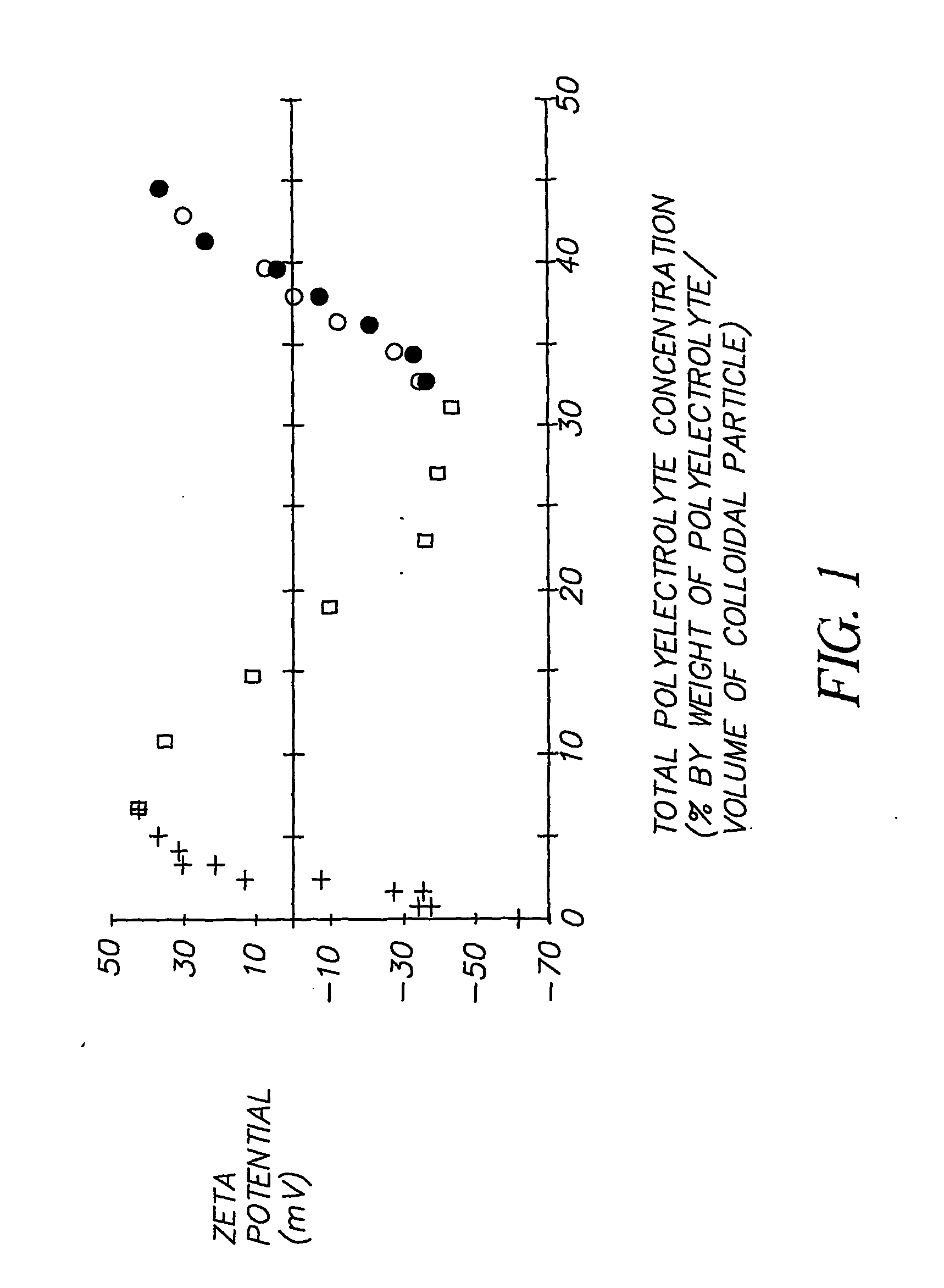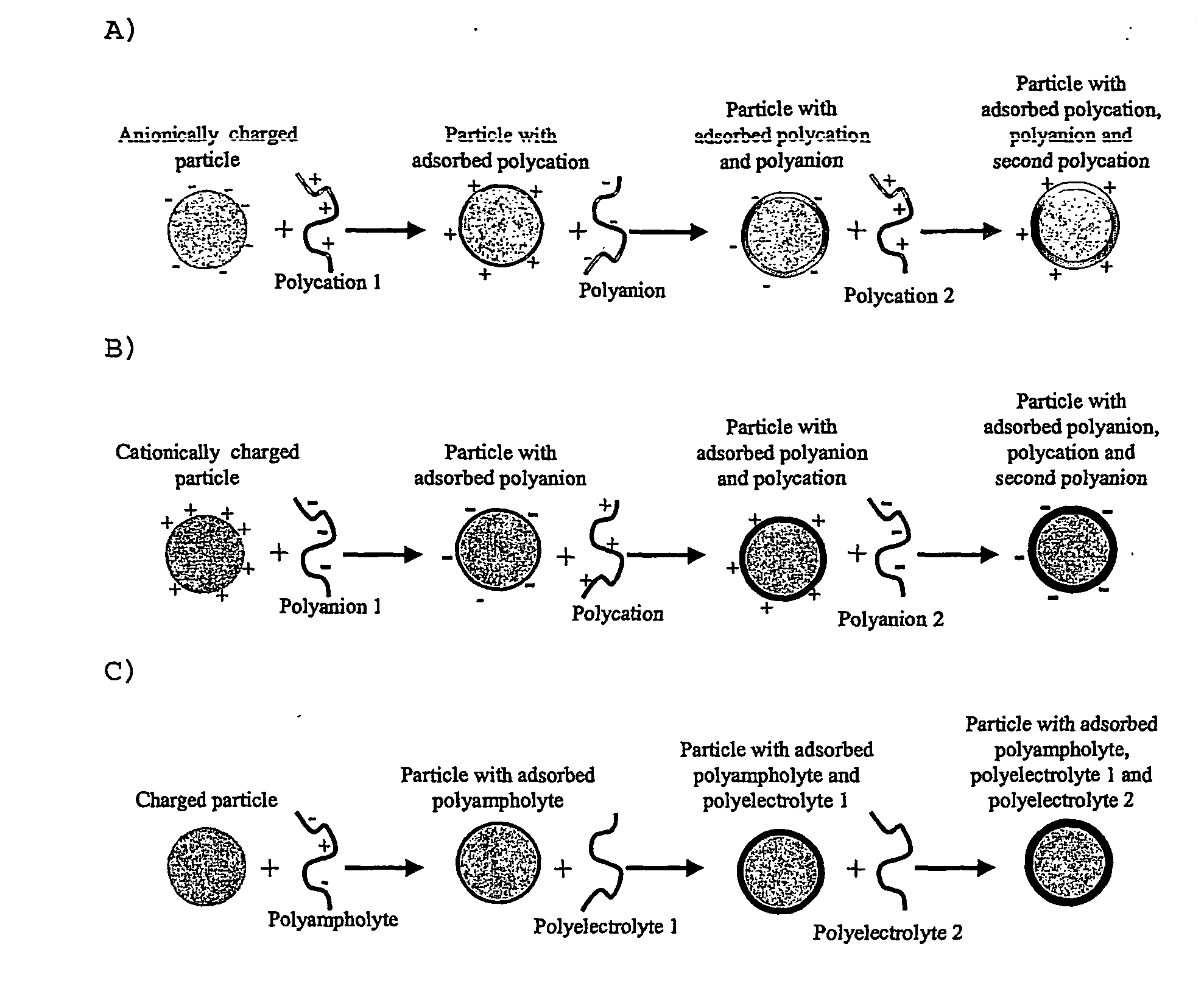Inkjet recording element comprising particles and polymers
a technology of particles and polymers, applied in the direction of duplicating/marking methods, coatings, printing, etc., can solve the problems of poor image stability in these systems, easy smudges, and slow swelling, and achieve the effect of high stability to ambient ozon
- Summary
- Abstract
- Description
- Claims
- Application Information
AI Technical Summary
Benefits of technology
Problems solved by technology
Method used
Image
Examples
example 1
Schematic Representation of the Formation of PEMs on Colloidal Particles
[0071] The following are schematic representations of some ways in which it is envisaged that the sequential association to a colloidal particle of polyelectrolytes may occur, leading to sequential charge reversals and build-up of a multilayer. The diagrams are included to assist in understanding the invention, without being bound by theory of the actual mechanisms that may be involved. It will also be understood that in addition to sequential association, for example as represented herein, the polyelectrolytes may alternatively be added as a mixture and not sequentially.
[0072] In these diagrams, the polyelectrolytes contain ionised or ionisable groups. Although the polyelectrolytes are drawn as highly charged, it may be possible that under the pH conditions of mixing the polymers are essentially uncharged. The addition of a third polyelectrolyte may cause charge reversal of the particle / polymer composite (as...
example 2
Coating of Particles
(a) Method
[0073] The coating formulations were made according to the experimental procedures described below. The formulations described all contained 15% w / w silica, corresponding to a volume fraction of 7.43%. Hand coatings were made from these formulations, with a blade set with a gap of 150 μm onto a 100 μm thick polyethylene terephthalate film with a 50 mg.m−2 dry gelatin ‘subbing’ layer. The film was held on a stainless steel platen by vacuum. Unless indicated the platen was maintained at 30 C by circulating water. The coatings were dried on the platen at this temperature, taking up to 45 min. to dry.
[0074] Where indicated, stirring was carried out using a magnetic stirrer bar. Filtration was carried out by transferring the sample into a syringe and passing through a 26 mm diameter cellulose acetate filter (Sartorius MINIART™) with pores of 5 μm diameter.
[0075] Each example relied on mixing colloidal suspensions and polymer solutions. The volume ratio...
example 3
Analysis of FIG. 1
[0081] In the experiments on which FIG. 1 is based the anionic silica used was LUDOX™ PW50 of particle diameter 77 nm. All materials are fully described in the Table above. In FIG. 1 and the following discussion the amount of polymer present is expressed as percentage weight of polymer per volume of particle. This is a useful measure as it is independent of the final particle concentration.
[0082] The zeta potential of a particle is a measure of the effective surface charge of the particle at the hydrodynamic slipping plane. The zeta potential may be determined from a particle's electrophoretic mobility. Here, the zeta potential was measured with a Malvern Zetasizer 3000HS instrument. For these measurements, the parent suspensions were diluted to 0.0500 v / v % (in the absence of polyelectrolyte) or 0.01250 v / v % (in the presence of polyelectrolyte) silica to avoid multiple scattering. All zeta potential measurements were made with solutions at 0.01 M NaCl at 25° C....
PUM
| Property | Measurement | Unit |
|---|---|---|
| equivalent spherical diameter | aaaaa | aaaaa |
| diameter | aaaaa | aaaaa |
| diameter | aaaaa | aaaaa |
Abstract
Description
Claims
Application Information
 Login to View More
Login to View More - R&D
- Intellectual Property
- Life Sciences
- Materials
- Tech Scout
- Unparalleled Data Quality
- Higher Quality Content
- 60% Fewer Hallucinations
Browse by: Latest US Patents, China's latest patents, Technical Efficacy Thesaurus, Application Domain, Technology Topic, Popular Technical Reports.
© 2025 PatSnap. All rights reserved.Legal|Privacy policy|Modern Slavery Act Transparency Statement|Sitemap|About US| Contact US: help@patsnap.com


